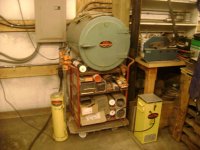Gary Fowler
Super Star Member
- Joined
- Jun 23, 2008
- Messages
- 11,917
- Location
- Bismarck Arkansas
- Tractor
- 2009 Kubota RTV 900, 2009 Kubota B26 TLB & 2010 model LS P7010
ShieldArc: Good info on rebaking, however I know that you know that that applies to using the rods on AWS Code related activities. ASME has similar restraints but that doesnt mean that you must follow that for your home products. I have thrown away tons of rods on the job over the years that were left out overnight because we would rather not take the chance on saving $100 worth of rods that may cause a multi-thousand dollar weld failure, plus rebaking and separate storage areas for them was too much trouble for minimal benefit. I wish I could have taken all those rods home for sure.
I kept my 7018 in a plastic container box sealed with tape for a couple of years before I found a good used rod oven which I now keep hot 24-7 @250F. Before that I had an old uninsulated wooden box with a heat lamp that stayed on till the bulb burned out and might be a few weeks before I found it off. (I turned that old box into a chicken nesting box minus the bulb). The rods still produced satisfactory welds for me, but I had to ground each one for a few seconds to burn off the moisture in them. Amazing how much steam one rod would pour off. The ends started rusting up on them but the fluxed areas was still clean so I looked for a a rod oven and found the 350# Phoenix oven for $250. I decided that was cheap enough to protect the 300 # off 7018 that I had. As a winter benefit, it also provides a bit of heat to my shop to help keep my water lines from freezing. As most welders are aware, these rod ovens come in 10#, 50#, 350# and 900# capacities. I think the 10# and 50# size unit only use about 150 watts of power when the element is heating so for small quantities that is cheap storage.
I kept my 7018 in a plastic container box sealed with tape for a couple of years before I found a good used rod oven which I now keep hot 24-7 @250F. Before that I had an old uninsulated wooden box with a heat lamp that stayed on till the bulb burned out and might be a few weeks before I found it off. (I turned that old box into a chicken nesting box minus the bulb). The rods still produced satisfactory welds for me, but I had to ground each one for a few seconds to burn off the moisture in them. Amazing how much steam one rod would pour off. The ends started rusting up on them but the fluxed areas was still clean so I looked for a a rod oven and found the 350# Phoenix oven for $250. I decided that was cheap enough to protect the 300 # off 7018 that I had. As a winter benefit, it also provides a bit of heat to my shop to help keep my water lines from freezing. As most welders are aware, these rod ovens come in 10#, 50#, 350# and 900# capacities. I think the 10# and 50# size unit only use about 150 watts of power when the element is heating so for small quantities that is cheap storage.
